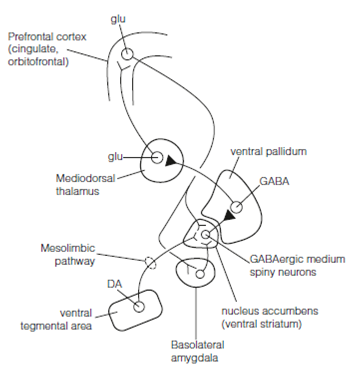Dopamine reward system
Dopaminergic neurons ascend from the ventral tegmental area (VTA) to the nucleus accumbens (nAc, ventral striatum) as the mesolimbic system and to the frontal cortex (including the cingulate and orbitofrontal cortex) as the mesocortical system. The mesolimbic system is frequently described as a reward system because:
- Firing of mesolimbic neurons increases in the presence of natural reinforcers such as food.
- Conscious, behaving rats will forego food or sex in order to stimulate their own mesolimbic neurons by pressing a lever to deliver a small current through electrodes chronically implanted into the medial forebrain bundle; a technique termed intracranial self-stimulation (ICSS).
- Natural rewards, ICSS, and addictive drugs all increase the release of dopamine in the nucleus accumbens and from mesolimbic terminals the reinforcing properties of all three are blocked through dopamine D1 receptor antagonists.
VTA neurons fire in response to a natural reward and the dopamine release facilitates learned associations with the reward, in animal studies a conditional stimulus—for example, light or tone—with which the reward has been paired. The learning occurs via the nucleus accumbens and the affective basal ganglia circuit. Subsequent firing of the VTA neurons depends on the predictability of the reward. Novel or unexpected rewards elicit a strong response, although this declines with repeated presentation—perhaps explaining why we eat more of a meal that consists of six courses of gourmet foods than a single bowl of rice. Predicted rewards have little effect, though conditioned stimuli associated with them continue to elicit dopamine release. Omission of a predicted reward decrease mesolimbic activity. The instant response to omission of an expected reward is to persevere with the activity which commonly provides it. So, low activity of mesolimbic neurons when a predicted reward is missed promotes reward-seeking behavior.

Figure: Simplified model of Mesolimbic reward system and affective basal ganglia circuit. DA, dopamine; GABA, g-aminobutyric acid; glu, glutamate. Excitatory, inhibitory.
The nucleus accumbens is the major target of the mesolimbic system. Like its dorsal striatum counterpart it has GABAergic medium spiny neurons (MSNs). This project to the GABAergic cells of the ventral pallidum (VP). Phasic dopamine release from terminals of VTA cells excites the MSNs, particularly if this coincides with excitatory input from the cortex or amygdala. Activity of the MSNs inhibits the GABAergic VP cells, hence disinhibiting the affective basal ganglia circuit. Distinct ensembles of MSNs respond differentially to cues associated with specific rewards.
The cingulate and orbitofrontal cortices respond to rewards and associated stimuli in a manner that depends on their predictability and seems to be concerned with evaluating their overall salience (importance) and determining the intensity of the behavioral response. In some cases at least the prefrontal cortex initiates goal-directed behavior via glutamatergic connections to the nucleus accumbens.